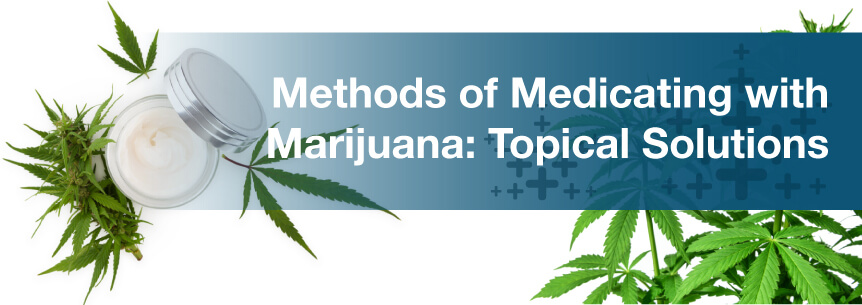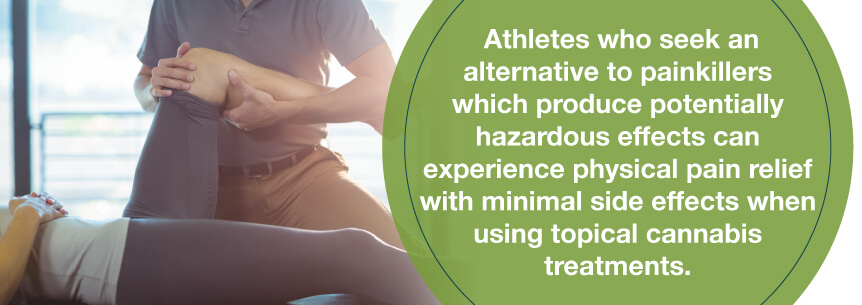
Did you know that marijuana can be used topically (on the skin) to relieve pain from certain conditions? Cannabis oil is used in balms, lotions, and ointments because of its alleged analgesic (pain relief) anti-inflammatory effects.
According to Marijuana and Medicine: Assessing the Science Base, marijuana is lipophilic, which means that it can be dissolved into a fat-soluble substance and readily enter cell membranes. In other words, it can be useful when applied topically.
It is important to note that marijuana will typically have no psychoactive qualities when applied topically. That means that this method of medicating with marijuana may be useful for times when ingesting or smoking marijuana is inappropriate.
Users enjoy the added benefits of targeted relief without igniting widespread effects that alter the entire body. When used efficiently, consumers can reap the benefits of traditional marijuana forms without inducing the typical “high” or psychological effects.
Rather than consuming marijuana through smoking, vaporizing or eating, local cannabis solutions offer a way to absorb the benefits of this substance through a simple medical spread. This newer method of cannabis ingestion consists of cannabis-infused topicals that absorb gradually into the pores of the skin. The cannabinoids allocated within the ointment’s composition produce the desired effects without eliciting a psychoactive result in the process.
Topical medical marijuana produces a host of benefits for users who desire an active solution against chronic pain, tension or inflammation. Manufacturers infuse various ointments, salves and patches with cannabinoids which localize relief for users who apply the topical solution to targeted areas.
Application-based cannabis works differently than its conventional vaporized or ingested counterparts.
Our body hosts two different cannabinoid receptors, referred to as the CB1 and CB2 receptors. The CB1 is a psychoactive receptor responsible for controlling and alleviating pain, while the CB2 is a non-psychoactive receptor that regulates pain and inflammation.
Once the user applies any topical marijuana to a specific location on the skin, the CB2 receptors on the surface layer of an individual’s flesh bind to the cannabinoids in each treatment. This effectively prevents the absorption of cannabis into the bloodstream by activating the endocannabinoid system that initiations a protective barrier.
The CB1 receptors prevent the body from breaking down an endocannabinoid referred to as anandamide, which permits the active flow of the therapeutic neurotransmitter while producing a non-psychoactive effect.
The slow absorption rate of the skin permits the therapeutic properties to last longer in a targeted area while prohibiting the effects of altered mental states from developing, too.
Topical solutions produce a localized effect on any area experiencing pain. While consuming marijuana affects the entire body and stimulates a widespread influence on your entire anatomy, the impact of topical cannabis reaches the areas solely where applied.
Choosing the right form of physical and therapeutic relief is often contingent upon the demands of the consumer. While the needs for medicinal marijuana will differ depending on each unique scenario, a variety of individuals can enjoy the benefits of a topical solution.

Athletes who seek an alternative to painkillers which produce potentially hazardous effects can experience physical pain relief with minimal side effects when using topical cannabis treatments. Whether an athlete has pain centered in the knee area or experiences a general discomfort in the entire leg, cannabinoids provide adequate pain relief when applied topically.
Individuals with skin rashes such as eczema and psoriasis can find relief through the antibacterial properties of topical cannabis, too. This form of treatment is ideal because it targets areas where irritation manifests.
Any person suffering from sudden aches or discomfort can apply topical medical marijuana for faster acting relief. Topical treatments absorb into the skin faster and consequentially produce effects more rapidly than when ingested.
Topical medical marijuana treatments are available in various skin-absorption forms, including:
Various types of cannabis topicals feature a fat-base composition and are available for purchase in salve or oil form. Choosing the right product depends on the desired consistency and treatment solutions for each consumer.
If your state allows for medical marijuana dispensaries, you may be able to purchase topical solutions at these clinics. Otherwise, you may make your own by mixing cannabis oil (using light almond oil or coconut oil is best) with beeswax or aloe vera:
Consider adding other therapeutic ingredients to your topical solution mix for enhanced results. For example, if you suffer from arthritis or extreme pain, add a teaspoon of cayenne pepper to your lotions for greater pain alleviation. For skin irritation or troublesome inflammation, mix peppermint or basil leaves into your cannabis oil and store your solution in a cool, temperature-controlled space.
Anecdotal evidence and reported uses for topical marijuana balms and oils include:
A major perk of opting for a topical rather than an ingested form of cannabis is the lack of psychological effects the consumer will experience. Smoking, vaporizing or eating cannabis affects the neurological system differently. Whether you opt for a marijuana balm or cannabis-infused patch, the THC is less likely to enter your bloodstream and produce halogenic or altered mental state results.
For any individual desiring the healing effects of cannabis without the resulting psychological effects, topical cannabis allows users to incorporate this product into their everyday routine without causing any sense of disruption. Consumers can follow their daily schedules while reaping the benefits they desire from cannabis. The application process is simple and hassle-free, too. When applying topical solutions, users do not require any additional accessories or supporting components for efficient use. Merely rub any lotions, balms or salves in the desired area where the benefits of cannabis are required or adhere patches to their appropriate locations.
The ease of application and the ability to retain a clear, unaltered state of mind allows users to resume their daily life as usual. Topical marijuana solutions also support an active, healthy lifestyle by promoting medical benefits for users who find themselves on the go.
Because ointments fixate on targeted area application, the usage of topic cannabis focuses on reaching the skin. Topical cannabis ointment is safe for the following areas:
Topical medical marijuana ointments provide effective relief to those desiring localized effects in areas where they experience discomfort.
Before you make or purchase a marijuana topical solution, you must first ensure you are in compliance with your state’s medical marijuana laws, obtain a recommendation from a qualified physician, and obtain a marijuana card, where applicable. If you are looking for a qualified medical marijuana doctor, MarijuanaDoctors.com can help. Use our search engine to book an appointment today with a certified marijuana doctor for more details, or to find the solution that best suits you.